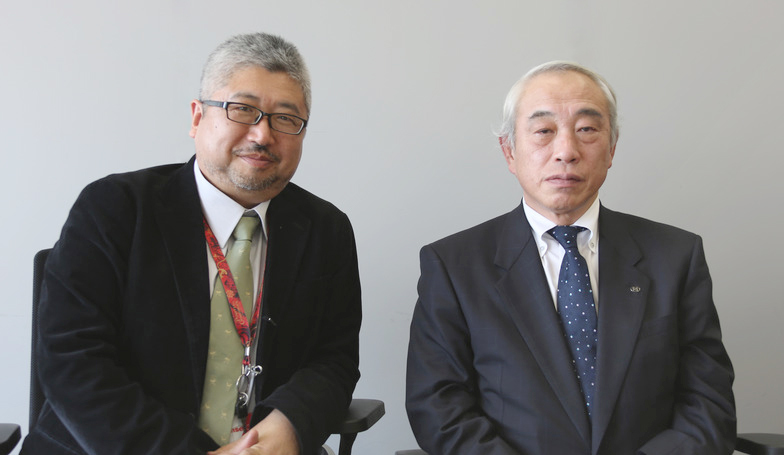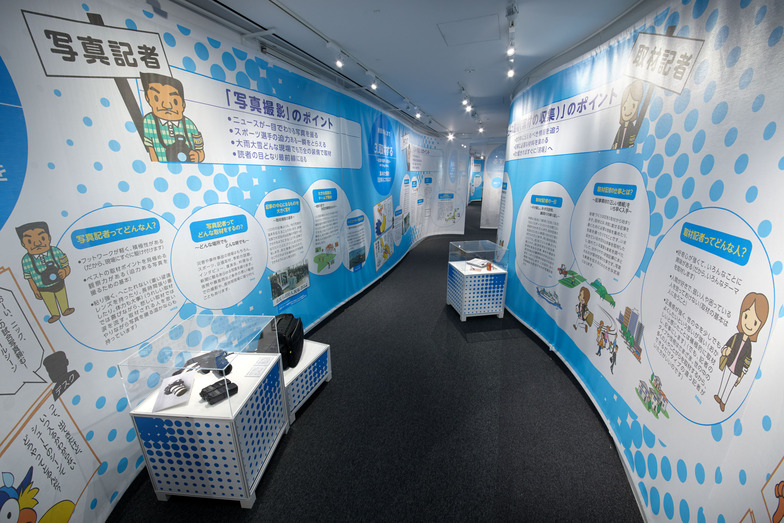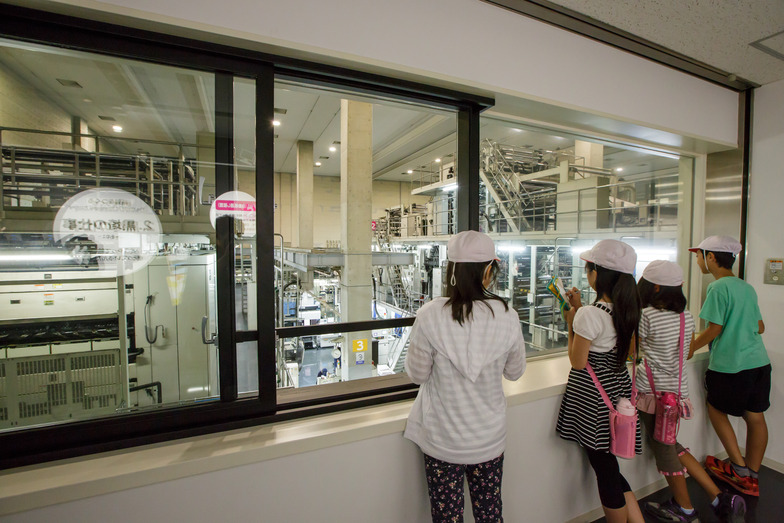In September 2014, the "Fun Newspaper Museum" opened at the Niigata Nippo newspaper's Kurosaki headquarters. The project team from the Niigata Nippo and Dentsu Inc. positioned this facility not merely as a "box," but as a new communication platform connecting with the local community and future readers. They advanced the project as an initiative where all Niigata Nippo employees committed to "the future of newspapers." A year and a half after opening, Hideaki Adachi, Managing Director of the Niigata Nippo, and Yoichi Matsumoto of Dentsu Inc. discuss the process, outcomes, and challenges.
Reporting & Editing: Aki Kanahara, Dentsu Inc. Event & Space Design Bureau

(From left) Mr. Matsumoto, Mr. Adachi
How did the "Omoshiro Shinbunkan" begin?
Matsumoto: Congratulations on reaching your first-year attendance goal of 10,000 visitors and on the continued growth in visitors.
Ata: Thank you.
Matsumoto: Over this past year, you've received four awards. Winning the Kids Design Award for contributions to children's education, along with recognition for spatial design, exhibition design, and theater visuals, demonstrates that you've created something truly unique across multiple dimensions. I'd like to look back on the project's beginnings. ( Details here )
Adachi: We already had visitor facilities within our headquarters building, and since we also had a printing plant on-site, we did offer tours. However, the exhibits were poor and didn't focus on "learning about newspapers in an enjoyable way." When the Niigata Nippo decided to relocate its headquarters functions back to downtown Niigata for the first time in 30 years, we saw it as an opportunity to redevelop the existing building.
Matsumoto: Why did the idea emerge to feature the factory in the tour?
Adachi: We previously had a tour course for children lasting about 30 minutes to an hour, but it never gained popularity, perhaps due to insufficient promotion. That old course incorporated the newsroom, focusing on editing and reporting, such as the work in the newsroom. Visitors could see the real deal, from the hectic scene of breaking news coming in all the way to the printing floor. However, departments other than printing moved to the new headquarters. Due to space constraints there, no tour route was established, leaving only this factory as an opportunity for tours.
Presenting newspaper work to children as entertainment

An entrance space that makes you feel like you've stepped into the "world of newspapers"
Matsumoto: What were your initial thoughts regarding this visitor facility project?
Adachi: Since we've moved headquarters three times since founding, we'd organized records each time, but initially we really struggled because there was so little to show. So our orientation shifted: rather than just conveying the Niigata Nippo itself, we wanted to change users' mindset—to make them think, "Newspapers are great, aren't they?"
Matsumoto: We developed it with the idea of spotlighting the newspaper company as a profession, directly connecting that to the need for children's social studies education. What was the initial internal reaction to this idea?
Adachi: It was a good challenge in helping everyone understand the consistent flow of newspaper production—from editing, advertising, reporting, and submission, through printing, to delivery to each household by sales staff. Even our own employees don't fully grasp every step, so it also served as an internal awareness campaign. Recently, newspapers have been pushed aside by smartphones and such, but we wanted people to understand the newspaper itself—to convey that this is what the entire newspaper process entails. We hope people will grasp the intent as entertainment: let's all trace the secret of how news is born, let's go on an adventure together.
Matsumoto: Comparing newspapers, TV, and the internet often leads to simplistic debates about which is the superior medium. Our exhibition approach reflects this critical perspective. Factory tours offer the persuasive power of "seeing things firsthand at the source" – a principle that also applies to newspaper reporting. Searching for information on Google versus physically experiencing what a rotary press is like offers entirely different dimensions of learning, right?
Adachi: Amid the factory tour boom, we saw positive reactions to hands-on experiences—like passing by a rotary press (though you can't touch it), smelling the ink, or getting your hands instantly black from newspaper type. Previously, visitors viewed presses through glass, but we created windows by drilling holes in the glass. This allowed them to experience the printing smell, airflow, sounds, and noise.
On the other hand, we haven't been able to offer tours of the editorial or advertising departments—the client-facing sides. Having more space would have helped, and figuring out how to make the editorial process feel more accessible remains a challenge for the future.

The "Cyan" hallway where you can learn about newspaper production

An exhibition window where you can experience the sheer power of the rotary press
Let's build "households with newspapers"!
Matsumoto: Despite being a completely reservation-based system and opening in September—a time that's hard to fit into school schedules—we welcomed 10,000 visitors in just one year. How has the response been?
Adachi: By the end of January in our second year, attendance had already surpassed 15,000. Over the last four months or so, the pace of visitors has increased dramatically. While the neighboring "Furusato Village" (Niigata Prefecture's product and tourism exhibition facility) has seen 300,000 visitors, so ours is minuscule by comparison. However, considering the previous facility only drew 3,000 visitors in a year, we've increased that number fivefold.
A survey of Niigata Nippo readers found that 60% of women in their 30s and 40s expressed interest in visiting. This aligns perfectly with the generation raising elementary and junior high school children. Since our core readership is currently older adults, we want children to discover the value of newspapers through experiences like this. Within our media strategy, "Building Households with Newspapers" is the main theme. If children visit, go home, and say, "The Niigata Nippo Newspaper Museum was great," we believe family bonding over this topic could deepen their understanding of newspapers, or even the Niigata Nippo itself.
When we asked visitors about their impressions of the "Fun Newspaper Museum," the most memorable comments were, of course, about the popular projection-mapped theater. But people were also really engaging with the content itself.
For example, they noted things like: "Newspapers have existed since Roman times, huh?" or "In Japan, they used to call them 'kawara-ban' (tile editions)!" On the technical side, comments included: "Newspapers express 20,000 colors using just four colors, huh?" or "The ink is made from a balance of water and oil, huh?" Regarding scale, there were surprises like: "Newspapers are like giant toilet paper rolls!" or "They use 1,900 kilometers of paper per day!" Then there's the reporter's camera bag on display – people exclaim "It's heavy!" and gain a real sense of how demanding the job is (laughs). We've received tons of feedback like "Now I understand how newspapers are made!" with all their various processes. Many visitors are also amazed by the "Newspaper Space" in the entrance atrium's atrium, and many have rediscovered the Niigata Nippo's history and its activities beyond publishing newspapers, like the citizen marathon, ekiden relay races, and art exhibitions.

A 3D mural showing the printing process at a glance

The wildly popular newspaper trick art
450 Niigata Nippo employees reconnect with and share the essence of their work
Matsumoto: This project was actually completed in a very short timeframe. Yet it involved a team effort spanning an incredibly diverse range of professions—from reporting to the moment the paper arrives at homes—akin to a department store of occupations. To explain the entirety of newspaper operations, we involved a large number of Niigata Nippo staff and created it using a workshop-like approach. We felt that simply outsourcing the work to Dentsu Inc., paying them, and having them deliver the finished product wouldn't truly leave a lasting legacy within your company.
Adachi: This project began about six months after our new headquarters building was completed. The planning phase took an overwhelmingly long time, and once construction started, it was a rush job. We caused you a lot of trouble, didn't we?
Though we're only an organization of about 450 people, opportunities for every section to come together, face the same direction, and work on something are rare. Representatives from every section—advertising, editorial, sales, printing—formed a preparatory committee and working teams and got moving. In the end, we worked together with Dentsu Inc. project team, going back and forth, trying different approaches. The major outcome was that everyone was able to return to the fundamentals of their own work, reflect on what their job truly entails, and gain a fresh understanding of what other sections do. I believe this served as a catalyst and will lay the groundwork for more company-wide, cross-departmental planning in future projects.
Matsumoto: Indeed, at the wrap-up party, people from various sections said things like, "I finally understand my own company."
※Continued in Part 2











